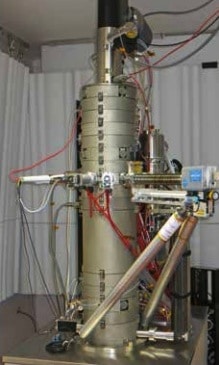
In his classic 1959 talk “There’s Plenty of Room at the Bottom: An Invitation to Enter a New Field of Physics” Richard P. Feynman challenged his fellow physicists to make the electron microscope 100 times better:
… It is very easy to answer many of these fundamental biological questions; you just look at the thing! You will see the order of bases in the chain; you will see the structure of the microsome. Unfortunately, the present microscope sees at a scale which is just a bit too crude. Make the microscope one hundred times more powerful, and many problems of biology would be made very much easier. …
But if the physicists wanted to, they could also dig under the chemists in the problem of chemical analysis. It would be very easy to make an analysis of any complicated chemical substance; all one would have to do would be to look at it and see where the atoms are. The only trouble is that the electron microscope is one hundred times too poor. …
I put this out as a challenge: Is there no way to make the electron microscope more powerful? …
Foresight Co-Founder Christine Peterson points to this announcement that shows Feynman’s challenge has been answered. A hap tip to Phys.org for reprinting this EPSRC press release “EPSRC unveils world-leading SuperSTEM microscope that sees single atoms“:
A new super powerful electron microscope that can pinpoint the position of single atoms, and will help scientists push boundaries even further, in fields such as advanced materials, healthcare and power generation, will be unveiled today, Thursday 19 February, by the Engineering and Physical Sciences Research Council (EPSRC).
The £3.7 million Nion Hermes Scanning Transmission Electron Microscope, one of only three in the world, will be sited at the EPSRC SuperSTEM facility at the Daresbury laboratory complex near Warrington, which is part of the Science and Technology Facilities Council (STFC).
The microscope not only allows imaging of unprecedented resolution of objects a million times smaller than a human hair, but also analysis of materials. This means that researchers will not only be able to clearly identify the atoms, but observe the strength of the bonds between them. This will improve understanding of their electronic properties when in bulk and how they may perform when used.
Minister for Universities, Science and Cities, Greg Clark, said: “The UK is a world leader in the development and application of STEM (Scanning Transmission Electron Microscope) techniques, and this new super-powerful microscope will ensure we remain world-class.”
“From developing new materials for space travel to creating a better, cheaper treatment for anaemia, this new super-powerful microscope lets UK scientists examine how materials behave at a level a million times smaller than a human hair. This exciting research will help lead to breakthroughs that will benefit not only our health but the environment too.”
Professor Philip Nelson, EPSRC’s Chief Executive said: “This EPSRC investment in state-of-the-art equipment is an investment in UK science and engineering. It will give scientists access to a tool that can delve into the heart of materials, discoveries made using this microscope will aid research and lead to innovations that benefit society and our economy. The EPSRC SuperSTEM facility at Daresbury has already delivered us new knowledge and applications and this new equipment will continue that pedigree.”
A SuperSTEM brochure provides several case studies that illustrate the capabilities of this new instrument. Not only is resolution better than 0.1 nm, but the microscope can identify the type of atom, its chemical bonding to its neighbors and its electronic environment, and do so under conditions that do not damage delicate materials. I would guess that Prof. Feynman would be pleased.
—James Lewis, PhD
